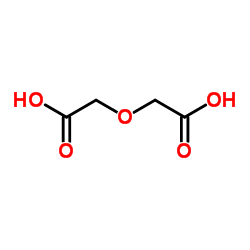Diglycolic acid inhibits succinate dehydrogenase activity in human proximal tubule cells leading to mitochondrial dysfunction and cell death.
Greg M Landry, Cody L Dunning, Taylor Conrad, Mallory J Hitt, Kenneth E McMartin
Index: Toxicol. Lett. 221(3) , 176-84, (2013)
Full Text: HTML
Abstract
Diethylene glycol (DEG) is a solvent used in consumer products allowing the increased risk for consumer exposure. DEG metabolism produces two primary metabolites, 2-hydroxyethoxyacetic acid (2-HEAA) and diglycolic acid (DGA). DGA has been shown to be the toxic metabolite responsible for the proximal tubule cell necrosis seen in DEG poisoning. The mechanism of DGA toxicity in the proximal tubule cell is not yet known. The chemical structure of DGA is very similar to citric acid cycle intermediates. Studies were designed to assess whether its mechanism of toxicity involves disruption of cellular metabolic pathways resulting in mitochondrial dysfunction. First, DGA preferentially inhibited succinate dehydrogenase, including human kidney cell enzyme, but had no effect on other citric acid cycle enzyme activities. DGA produces a cellular ATP depletion that precedes cell death. Human proximal tubule (HPT) cells, pre-treated with increasing DGA concentrations, showed significantly decreased oxygen consumption. DGA did not increase lactate levels, indicating no effect on glycolytic activity. DGA increased reactive oxygen species (ROS) production in HPT cells in a concentration and time dependent manner. These results indicate that DGA produced proximal tubule cell dysfunction by specific inhibition of succinate dehydrogenase and oxygen consumption. Disruption of these processes results in decreased energy production and proximal tubule cell death. Copyright © 2013 Elsevier Ireland Ltd. All rights reserved.
Related Compounds
| Structure | Name/CAS No. | Molecular Formula | Articles |
|---|---|---|---|
 |
Diglycolic acid
CAS:110-99-6 |
C4H6O5 |
|
Covalent bridging of surface functionalized Fe3O4 and YPO4:E...
2015-09-07 [Dalton Trans. 44 , 14686-96, (2015)] |
|
Diglycolic acid is the nephrotoxic metabolite in diethylene ...
2011-11-01 [Toxicol. Sci. 124 , 35-44, (2011)] |
|
Identification and analysis of an impurity inducing clinical...
2013-11-01 [J. Pharm. Biomed. Anal. 85 , 21-7, (2013)] |
|
Preparation of needle-like aragonite particles from calcium ...
[Acta Chim. Slov. 4(2) , 3-10, (2011)] |